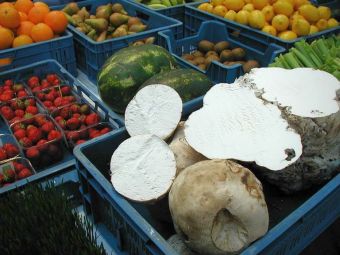
A famous scientist’s father asked the man to describe a specific bird. The scientist used impressive language. The father then told the young man his description told him nothing about the bird. The words were mere man-made classification terms.
The scientist took the lesson to heart. He became the famous nuclear physicist, Richard Feynman. In discussing puffballs and the other fungi, we will avoid scientific jargon or lingo. Instead, we will speak of what they are and why they are special.
As a child, you may have been running in a field and spotted what looked like an odd round or egg-shaped white to greenish-brown object. It may have been smooth, or it may have had small warts or spikes all over the surface. If you went to pick it up or you kicked it, it may have puffed a dark powder toward you. What you saw was probably the fruiting body1 of a puffball. Notice a few examples of puffballs, some with and some without small openings²2 to release spores.
Puffballs – Edible or Not?
Most puffballs are not poisonous, but there are exceptions. And there are other mushrooms that when they are first developing may resemble a very small puffball, but are in fact poisonous. Cutting them open will probably reveal the truth. Even if a puffball is of an edible variety, it is important to cut it open to determine if it is at an edible stage of development. It must be consistently white inside, free of spores. If there is any sign of gills, it is not suitable as an eating puffball. Dispose of it! An excellent article on puffballs as food, including puffball recipes, discusses the Calvatia, Calbovista, and Lycoperdon varieties.
Bracket Fungi
There are a number of relatively hard fungi that assume the form of brackets or small shelves. I recently discovered one at the edge of a wood near a friend’s house in Virginia. I have tentatively identified it as Laetiporus sulphureous, or chicken-of-the-woods fungus. Purportedly, a world record specimen was identified, weighing an amazing 100 lbs. When young and cooked it is reputed to taste like chicken, hence the name.
Jelly Fungi
As is the case of bracket fungi, jelly fungi grows on wood. It often has a softer, rubbery consistency and is used in oriental cuisine. The author has, in fact, enjoyed food cooked by friends from Mainland China who were visiting professors, that contained wood ear, Auricularia polytricha. Though it possesses little flavor, wood ear offers a pleasing texture with medicinal benefits.
Earthstars
The author has also had the good fortune of discovering earthstars found on his own property, including one fairly spectacular (if inedible) Scleroderma specimen. These fungi offer a certain kind of beauty so the author welcomed them on his property. See what you think of the one I memorialized below.
In Conclusion
We’ve only very lightly touched on the world of fungus; there is so much more to learn on the subject, and so many more interesting varieties that could be discussed. It is hoped the reader will have, if not a lot more information at his or her fingertips, certainly a greater appreciation for these humble lifeforms.
Update: I decided to embed a YouTube video entitled “Three Ways to Cook Puffball Mushrooms.” The recipes may or may not be your cup of tea, but the preparation of the mushroom is beautifully delineated.
1 The above-ground portion of a fungus is likened to fruit. As a fruit may be removed from a tree without damaging the tree, a puffball may be removed from the ground without damaging the underground part of the organism.
2 Puffballs with holes at the top may puff out spores upon being struck by raindrops. This may be to insure sufficient moisture for germination.
Note: You may also enjoy the article Gathering Morel Mushrooms
References:
- Australian National Herbarium: The Giant Puffball
- First-Nature: Bracket and Crust Fungi Gallery
- MushroomExpert: Jelly Fungi
- Utah State University – Intermountain Herbarium: Fun Facts About Fungi